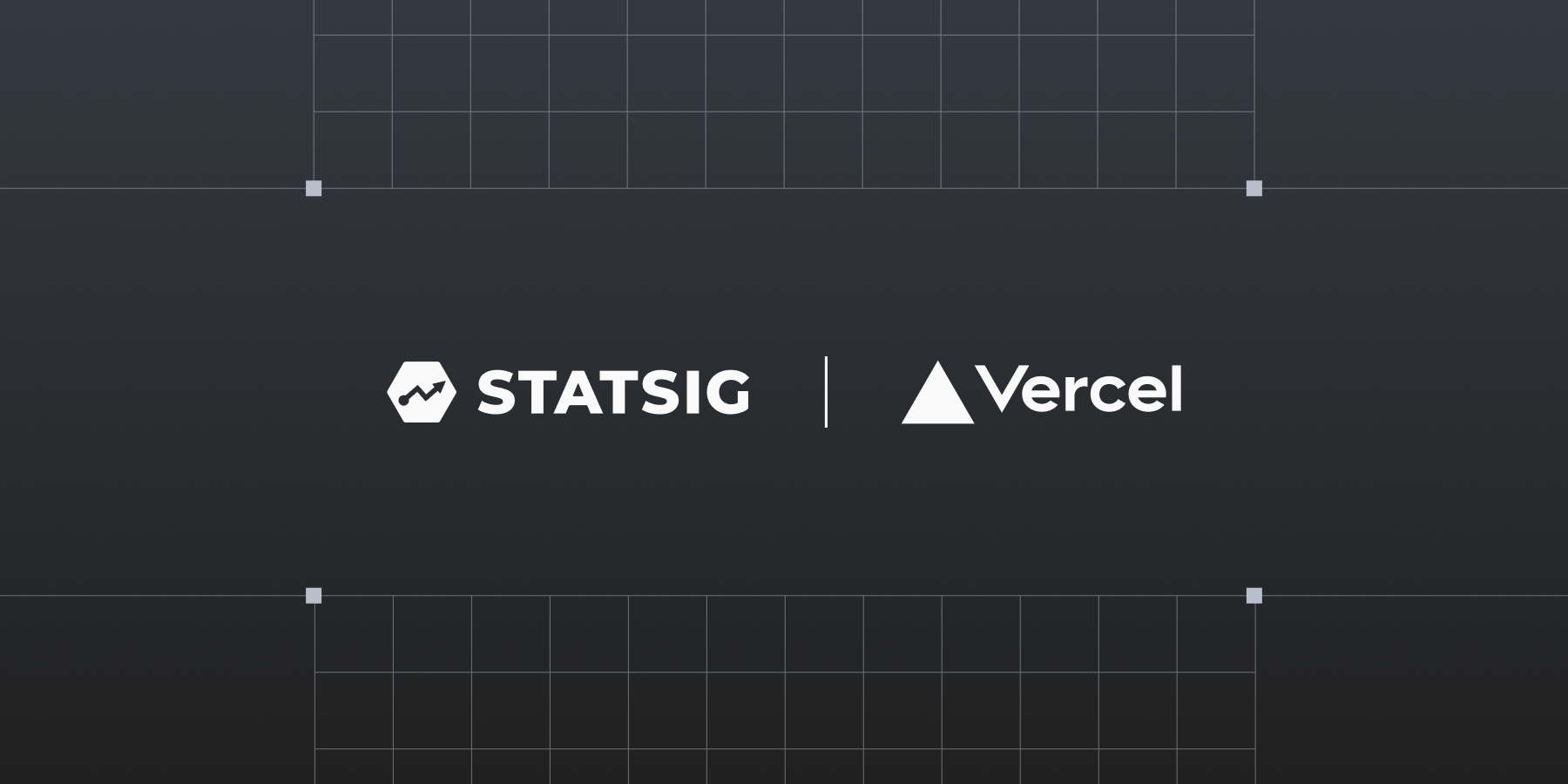
Modern web development depends on a seamless experience for users and developers.
Performant, fast, and reliable websites are table stakes for users in 2025. At the same time, websites and applications are becoming increasingly complex, with more features, integrations, and components contributing to the user experience. This complexity makes it more difficult to optimize performance because there are so many variables at play.
To tackle this, developers need the ability to test new ideas, control rollouts, and measure impact—all in a way that is intuitive, collaborative, and built for scale. Feature flags and experimentation make this possible, allowing teams to control releases, test changes with real users, and make data-driven decisions that enhance performance.
However, these tools can create friction for both the developer and the user. No developer wants to manage extra configurations, third-party dashboards, or custom integrations, and no user wants to see a page flicker on load, or experience another 100ms wait until the page renders.
But what if you could manage feature flags and experiments directly within your deployment workflow, without compromising performance?
With the Statsig <> Vercel Native Integration, now you can.
Try Statsig on Vercel

Announcing the Statsig <> Vercel Native Integration
The Statsig <> Vercel Integration is a native solution that utilizes Statsig’s feature flagging and experimentation tools to configure, test, and optimize web experiences within Vercel.
With this integration, you can:
Create and manage feature flags to control your releases
Run experiments to test changes and measure impact
Gain access to Analytics, Session Replay, and other Statsig product tools that don’t exist natively in your Vercel dashboard
Use Statsig’s SDKs and Edge Config syncing for low-latency performance without additional setup
These development tools are powered by the Statsig platform, built by engineers who pioneered large-scale experimentation at Facebook. Today, some of the most innovative companies—including OpenAI, Notion, and Atlassian—use Statsig to ship with confidence, manage features at scale, and make data-driven decisions.
With this integration, developers can choose between Vercel’s Flags SDK or Statsig’s Flags SDK, depending on your needs:
Vercel’s Flags SDK is a free, open-source library designed for Next.js and SvelteKit projects. It enables fast, server-side feature flagging and experimentation via Edge Middleware with no layout shift, works seamlessly with Statsig via an adapter, and integrates with Flags Explorer for easy overrides
Statsig’s SDK is best for any projects not using Next.js and Sveltekit and provides full experimentation, analytics, and advanced feature management. Statsig SDKs also use Edge Config syncing to ensure lightning-fast performance for end-users is never compromised
Get started in <60,000ms
The Statsig <> Vercel Native Integration is designed to give developers seamless feature management with zero overhead and sub-millisecond performance.
Install the integration: Find Statsig in the Vercel Marketplace and complete the quick setup flow
Choose a billing plan: Both plans offer generous limits: the Free tier includes 2M events/month, while the Pro tier provides 5M events/month for just $150
Install Statsig and connect your Statsig project : Link your Statsig project to Vercel to sync feature flags, experiments, settings, permissions, etc.
Initialize with Vercel’s Flags SDK or Statsig's SDK: We recommend using Vercel's Flags SDK for Next.js and SvelteKit projects; use Statsig’s SDK for all other projects
Ship with confidence: Manage your features, tests, and rollouts from the Flags tab in the Vercel toolbar
Best of all? You can be fully set up in under 60 seconds—and scale effortlessly as your needs grow.
Optimize performance while reducing overhead
Managing feature flags and running experiments shouldn’t have to add complexity to your workflow, or slow down your application. The integration is built with a seamless experience in mind for both developers and end-users:
No managing permissions, no switching tools: Project permissions and settings stay in sync automatically, ensuring updates are instantly reflected across your teams and projects. Manage flags and experiments directly from the Vercel dashboard without toggling platforms
More value, lower cost: With Statsig’s Free and Pro tiers, developers get access to powerful experimentation and analytics at a fraction of the cost of other solutions
High performance, even at scale: Unlike traditional integrations that introduce latency, Statsig leverages Edge Config syncing, ensuring feature flags update instantly without extra network requests. The result? No flickers, no delays—just real-time control over your app experience.
By combining Vercel’s high-speed Edge Network with Statsig’s real-time feature flagging and experimentation, teams can move faster, optimize every release, and deliver better web experiences—all without trade-offs.
How to use the Statsig <> Vercel Native Integration
After installing the integration, you can initialize with Flags SDK or Statsig’s SDK to gain access to:
Feature flags: Gain complete control over your releases
Feature flags give you fine-grained control over what gets released and when—without requiring redeployments. Statsig pairs feature flagging with real-time performance data, allowing you to monitor release impact, catch regressions early, and make informed rollout decisions.
This integration keeps permissions and project settings in sync between Statsig and Vercel, so teams can maintain a consistent workflow without extra setup.
For example, if you're introducing a new navigation layout, you can first enable the flag for internal users, gather feedback, and then gradually roll it out to production—all without pushing a new deployment. From the Flags tab, you can quickly enable, disable, or update feature flags—ensuring smooth rollouts without disrupting your deployment process

Experimentation: Ship smarter with every test
Experimentation is essential for refining web experiences, allowing teams to test changes and measure their impact before rolling them out. While Vercel has long focused on fast deployments, this is its first native integration for advanced A/B testing, giving developers built-in experimentation tools without the extra setup.
With automated metric tracking and multi-metric impact analysis, Statsig helps teams understand how product changes may affect key performance metrics. This makes it easier to spot trends, validate hypotheses, and identify trade-offs.
For example, if you wanted to compare two homepage designs, you could create a new experiment in Statsig, define your test groups by setting bucket parameters, and start the experiment. Once the experiment is live, users will be automatically assigned to a group and real-time metric reporting will start immediately. See the screenshot below for an example experiment setup.

Just like flags, you can monitor and manage your experiments directly from the Flags tab in the Vercel toolbar, allowing you to configure experiments and analyze results without leaving your deployment workflow.

Once the experiment has collected enough data, Statsig’s analytics will highlight statistically significant differences in performance between test groups. This allows you to make data-driven product decisions—whether it’s adopting the better-performing version, iterating on the design, or running additional tests to refine your findings.
Product Analytics & Session Replay - Extra insights beyond the integration
By signing up for Statsig’s Free or Pro tier through the integration, developers gain access to additional powerful tools beyond feature flags and experimentation—Product Analytics and Session Replay. While these tools won’t appear natively in the Vercel dashboard, they provide deeper insights into user behavior, feature performance, and product impact.
Product Analytics seamlessly integrates metrics with feature releases and experiments, helping teams identify trends, test hypotheses, and measure impact in real time. Whether using Statsig Cloud or your own data warehouse, our product analytics delivers fast, reliable insights to guide product decisions.
Session Replay captures real user interactions, allowing teams to troubleshoot issues, analyze behavior, and refine experiences with visual context. By replaying sessions, developers can quickly pinpoint usability problems and optimize their product.
To get started with either of these features, all you need to do is drop a script tag into the head of your Vercel site.
Closing thoughts
Statsig is thrilled to partner with Vercel to bring feature management and experimentation directly into your Vercel dashboard. By combining Vercel’s fast, scalable deployment platform with Statsig’s powerful feature flagging and experimentation engine, developers get the perfect blend of speed and control—helping teams ship confidently and optimize every release.
Get started today by installing the Statsig integration from the Vercel Marketplace! If you have questions or suggestions, reference our docs, or reach out to our team—either on Slack, or via email.
Happy building!
Request a demo

